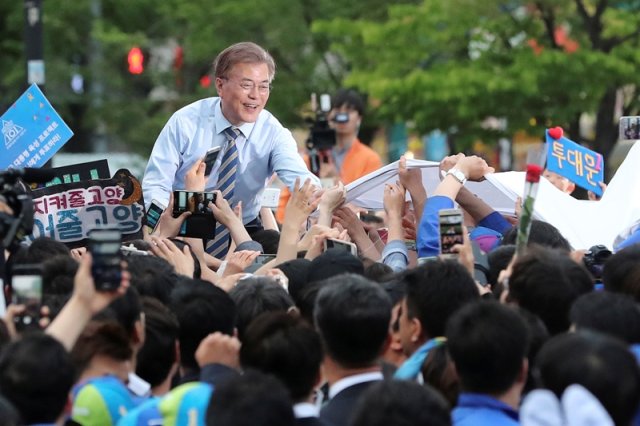
Moon Jae-in, of the liberal Democratic Party, won South Korea’s May 9 presidential election with 41% of the vote, easily defeating his arch-conservative opponent Hong Jun-pyo, who won about 24%.
The elections took place after the impeachment of conservative president Park Geun-hye for her involvement in a huge corruption scandal. Park, from Hong’s right-wing Saenuri Party (renamed Liberty Korea Party in a bid to rebrand), was forced out by the huge “Candlelight Revolution”. Millions of Koreans mobilised in an ongoing series of candlelight protests to demand her impeachment.
The elections also took place in a context of the threat of war in the Korean Peninsula with US President Donald Trump’s administration ratcheting up tensions with North Korea.
A liberal candidate, Moon advocates engagement with the North to defuse tensions, against Hong’s militarist hard line attitude.
Youngsu Won, a left-wing activist and coordinator of the International Forum in Korea, spoke to Green Left Weekly’s Stuart Munckton about the elections.
***
What do you think Moon’s victory represents?
Moon’s triumph is impressive, but not overwhelming, even though the margin is rather big. His election is largely due to the historic candlelight protests.
Hong was a kind of improvised candidate after a series of failures by the conservatives to field a competitive candidate. Though he won less votes than previous conservative candidates, and in spite of a ridiculous framework of struggle against the pro-North left, Hong had some success in reuniting conservative voters.
On the other hand, Yoo Seung-min, a “reforming” conservative, failed to win the hearts and minds of conservative voters, who considered him a traitor for leaving the Saenuri Party with other anti-Park MPs to form the Bareun Party.
Hong’s success and Yoo’s failure shows how rotten and insane the mindset of conservative voters are — who cast votes en masse for the party of the disgraced Park.
What impact did the huge Candlelight Revolution have on the result? What can we expect now from the organisers and participants in those mass actions?
The grassroots participants in the Candlelight Revolution are content mostly with Park’s impeachment and the liberal victory in the presidential elections. The mainstream liberals, mostly supporters of Moon, identify the candlelight protests with the electoral success.
However, other progressive sectors differ in that they think the candlelight protests should not be confined to the electoral framework, but as a potential first step for further, thorough reform of South Korean politics and economy as a whole. They welcome Moon’s victory, but will be critical of his government.
What was the impact of the heightened tensions with North Korea, as part of the US war drive? Will a Moon Jae-In administration defuse tensions?
Luckily for Moon, tensions in the Korean peninsula didn’t have an impact on the election. The so-called North Korean factor has been repeatedly used by the conservatives, as well as by the government and intelligence agencies.
In the recent period, the conflict was mainly between North Korea’s Kim Jong-un and Trump. The security-related debate was over the THAAD missile systems, which the outgoing government and the US introduced without proper procedures before the election.
What attitude did the left and trade unions take to the presidential elections?
Shim Sang-jeong of the Justice Party was the only progressive candidate, besides a candidate from a successor party of the pro-North Korea United Progressive Party (UPP) that was banned by Park’s government in 2012.
Shim’s campaign was successful, and she performed well in TV debates in the face of other liberal and conservative adversaries. In spite of high expectations, the final result was a bit disappointing at 6%.
The Korean Confederation of Trade Unions (KCTU) and the radical left were just spectators in the elections, as no attempt to field a worker or leftist candidate was made. Before the elections, the pro-North tendency pushed hard for the KCTU to build a new workers’ party.
At the moment, the pro-North forces are scattered in different groups and feel they need a new, broad political framework to get involved in — hopefully, a version 2.0 of the Democratic Labour Party (which was one group that helped form the now-banned UPP).
What is the approach of the left, unions and social movements to the US imperialist tensions with North Korea?
Most South Koreans, not just radical activists, are against the unnecessary tensions on the Korean peninsula and want a nuclear-free peace.
The North Korean regime’s argument of self-defence doesn’t appeal to South Koreans. A series of missile tests by the North provided the rationale for the conservatives to introduce the THAAD missile system, in spite of the stubborn resistance of locals in the region. Introducing the THAAD missile system enraged China, and the Sino-South Korean relationship has seriously worsened.
Thus, South Koreans are stuck in an unwanted and unnecessary conflict between North Korea and the US. Social movements are critical of US interventionist moves, but at the moment, no mass movement is being organised to confront the hostile situation.
What can we expect from a Moon Jae-in presidency for South Korea and internationally?
Moon’s government will revive the Sunshine Policy (of greater engagement) toward North Korea and the hostile policy of the previous conservative governments will end soon. He will also seek to improve relations with China and ease tensions.
However, Moon is forced to deal with Trump and his insane, ignorant drive towards confrontation with North Korea.
In short, the security-related environment is very tough, and Moon needs to prove his real political capacity to deal with competing superpowers to work for peace and coexistence on the peninsula.
Like the article? Subscribe to Green Left now! You can also like us on Facebook and follow us on Twitter.